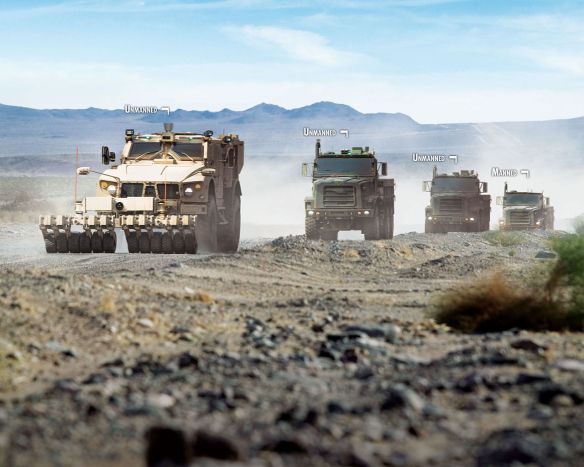In convoy, an M-ATV with mine roller attachment) and two MTVRs with TerraMax. The third MTVR is manned.
A close-up view on the all-so-important roof mounted sensors of the Terramax to provide the system with a clear view of what is lying ahead of “him”, but which makes one wonder why the windscreen needs to be kept so clean!
Driving development on UGVs at the beginning of the century have been the small mine clearance or explosive ordnance disposal (EOD) UGVs and those used to scout hostile buildings during the Afghanistan campaign. Removing – or at least thoroughly assessing – the danger of a situation before sending a human into the area has since proved something of a strategic preference in military planning across all domains as we move forward.
Of note in the EOD space have been the TerraMax 6×6 autonomous vehicle from Oshkosh – which provides route clearance, aside to a number of other functions, and has been procured by the US and British militaries.
If an American manufacturer of large vehicles were to be tagged as one of the leaders in the field of heavy robotised vehicles that would definitely be Oshkosh Defense. It started developing the TerraMax robotic technology in the early 2000 under a Darpa solicitation. Following years of development and refining, in August 2012 the US Marine Corps Warfighting Lab and Oshkosh Defense applied the TerraMax technology to test a convoy that included five normal and two uninhabited vehicles. The latter travelled in full autonomous mode albeit under the monitoring of an operator equipped with a remote-control unit. While the company remains committed to the US Office of Naval Research Cargo UGV project, which seeks to bring robotic capabilities to logistics convoy missions to help reduce troops’ exposure to threats, Oshkosh is also looking at other applications for its TerraMax, which is constantly being upgraded.
At AUVSI 2014 and Eurosatory 2014 Oshkosh exhibited a company M-ATV equipped with a Humanistic Robotics route clearance roller capable to work in full autonomy. Vehicle dynamics were adapted to the roller, and Oshkosh will carry on experimentations for the next couple of years on route clearance operations. The demonstrator shown in Paris was equipped with a roof-mounted lidar. This is regarded as a prime sensor and is particularly efficient in dust conditions, assisting the radars installed at each corner of the vehicle, while electro-optic sensors are used to allow the operator to have a clear view of the situation. The upgrades consisted mostly in the adoption of a new and faster computer able to cope with a higher sensor resolutions required for increased perception of the vehicle’s surroundings, which includes detecting obstacles in dust or vegetation and in turn allow the vehicle to move faster (exactly like a motorist is able to drive faster at night if given more powerful headlights). The new kit features an open architecture, improving the TerraMax’s ability to accept new types of sensors.
